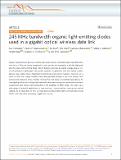Files in this item
245 MHz bandwidth organic light-emitting diodes used in a gigabit optical wireless data link
Item metadata
| dc.contributor.author | Yoshida, Kou | |
| dc.contributor.author | Manousiadis, Pavlos | |
| dc.contributor.author | Bian, R | |
| dc.contributor.author | Chen, Z | |
| dc.contributor.author | Murawski, Caroline | |
| dc.contributor.author | Gather, Malte Christian | |
| dc.contributor.author | Haas, H | |
| dc.contributor.author | Turnbull, Graham A. | |
| dc.contributor.author | Samuel, Ifor David William | |
| dc.date.accessioned | 2020-03-09T10:30:02Z | |
| dc.date.available | 2020-03-09T10:30:02Z | |
| dc.date.issued | 2020-03-03 | |
| dc.identifier | 265380111 | |
| dc.identifier | 77612620-e94b-4f02-bb53-6f763e681a07 | |
| dc.identifier | 85081042401 | |
| dc.identifier | 000519260700006 | |
| dc.identifier.citation | Yoshida , K , Manousiadis , P , Bian , R , Chen , Z , Murawski , C , Gather , M C , Haas , H , Turnbull , G A & Samuel , I D W 2020 , ' 245 MHz bandwidth organic light-emitting diodes used in a gigabit optical wireless data link ' , Nature Communications , vol. 11 , 1171 . https://doi.org/10.1038/s41467-020-14880-2 | en |
| dc.identifier.issn | 2041-1723 | |
| dc.identifier.other | ORCID: /0000-0002-4857-5562/work/70619053 | |
| dc.identifier.other | ORCID: /0000-0001-8678-9126/work/70619055 | |
| dc.identifier.other | ORCID: /0000-0002-9995-6525/work/70619082 | |
| dc.identifier.uri | https://hdl.handle.net/10023/19619 | |
| dc.description | Funding: UK EPSRC (EP/K00042X/I, EP/R005281/1, EP/R007101/1 and EP/R035164/1); Marie Skłodowska Curie Individual Fellowship (703387). | en |
| dc.description.abstract | Organic optoelectronic devices combine high-performance, simple fabrication and distinctive form factors. They are widely integrated in smart devices and wearables as flexible, high pixel density organic light emitting diode (OLED) displays, and may be scaled to large area by roll-to-roll printing for lightweight solar power systems. Exceptionally thin and flexible organic devices may enable future integrated bioelectronics and security features. However, as a result of their low charge mobility, these are generally thought to be slow devices with microsecond response times, thereby limiting their full scope of potential applications. By investigating the factors limiting their bandwidth and overcoming them, we demonstrate here exceptionally fast OLEDs with bandwidths in the hundreds of MHz range. This opens up a wide range of potential applications in spectroscopy, communications, sensing and optical ranging. As an illustration of this, we have demonstrated visible light communication using OLEDs with data rates exceeding 1 gigabit per second. | |
| dc.format.extent | 7 | |
| dc.format.extent | 887539 | |
| dc.language.iso | eng | |
| dc.relation.ispartof | Nature Communications | en |
| dc.subject | QC Physics | en |
| dc.subject | TK Electrical engineering. Electronics Nuclear engineering | en |
| dc.subject | DAS | en |
| dc.subject | BDC | en |
| dc.subject.lcc | QC | en |
| dc.subject.lcc | TK | en |
| dc.title | 245 MHz bandwidth organic light-emitting diodes used in a gigabit optical wireless data link | en |
| dc.type | Journal article | en |
| dc.contributor.sponsor | EPSRC | en |
| dc.contributor.sponsor | EPSRC | en |
| dc.contributor.sponsor | EPSRC | en |
| dc.contributor.sponsor | European Commission | en |
| dc.contributor.institution | University of St Andrews. School of Physics and Astronomy | en |
| dc.contributor.institution | University of St Andrews. Sir James Mackenzie Institute for Early Diagnosis | en |
| dc.contributor.institution | University of St Andrews. Centre for Biophotonics | en |
| dc.contributor.institution | University of St Andrews. Biomedical Sciences Research Complex | en |
| dc.contributor.institution | University of St Andrews. Condensed Matter Physics | en |
| dc.identifier.doi | https://doi.org/10.1038/s41467-020-14880-2 | |
| dc.description.status | Peer reviewed | en |
| dc.identifier.url | https://www.nature.com/articles/s41467-020-14880-2#Sec14 | en |
| dc.identifier.grantnumber | EP/R035164/1 | en |
| dc.identifier.grantnumber | EP/K00042X/1 | en |
| dc.identifier.grantnumber | EP/R005281/1 | en |
| dc.identifier.grantnumber | 703387 | en |
This item appears in the following Collection(s)
Items in the St Andrews Research Repository are protected by copyright, with all rights reserved, unless otherwise indicated.

